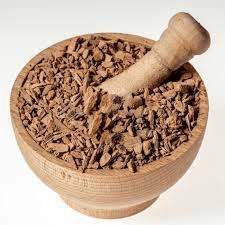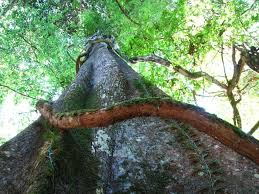Maytenus krukovii, commonly known as Chuchuhuasi, is a notable plant species indigenous to the Amazon rainforest, particularly found in parts of Peru and other South American countries. This medium-sized tree belongs to the Celastraceae family and has gained prominence for its traditional uses in indigenous medicine.
Chuchuhuasi is recognized for its robust and straight trunk, which can reach heights of up to 25 meters. The tree’s bark is a key element of interest, as it contains a variety of compounds that are believed to have medicinal properties.
Traditional healers and indigenous communities have utilized Chuchuhuasi for centuries, employing different parts of the plant in various medicinal preparations.
In traditional Amazonian medicine, Chuchuhuasi is often used to address a range of ailments. The bark is reputed to have anti-inflammatory and analgesic properties, and infusions or decoctions made from the bark are employed to alleviate pain and reduce inflammation.
Additionally, Chuchuhuasi is believed to possess adaptogenic qualities, supporting the body’s ability to adapt to stress and promoting overall well-being.
Scientific interest in Chuchuhuasi has grown, leading to research aimed at understanding the chemical composition of its bark and exploring potential pharmacological applications.
Some studies have identified alkaloids, tannins, and other bioactive compounds in Chuchuhuasi, contributing to its potential medicinal effects.
Cultivation of Maytenus krukovii has expanded beyond its native habitat, with efforts to grow the plant in other suitable climates. As the scientific community delves deeper into the properties of Chuchuhuasi, the plant continues to be a subject of interest for both traditional medicine practitioners and researchers exploring the therapeutic potential of natural compounds derived from the Amazon rainforest.
The Botanical Description of Maytenus krukovii
1. Leaf Structure: Maytenus krukovii features simple, alternate leaves with a glossy, leathery texture. The leaves are lanceolate, elongated, and often have finely serrated margins.
2. Growth Form: This medicinal plant exhibits a shrub or small tree growth form, reaching heights of 2 to 5 meters. The branches are typically slender and may display a reddish-brown hue.
3. Flower Characteristics: Maytenus krukovii produces small, inconspicuous flowers that are greenish-yellow in color. These flowers are arranged in clusters, contributing to the plant’s overall aesthetic.
4. Bark Texture: The bark of Maytenus krukovii is smooth and may vary in color from grayish-brown to reddish-brown. Over time, it may develop a characteristic fissured texture.
5. Root System: The plant is known for its well-developed, fibrous root system, which aids in nutrient absorption and overall stability.
6. Fruit Description: Maytenus krukovii bears small, spherical fruits that mature to a reddish or purplish color. These fruits contain seeds and contribute to the plant’s reproductive cycle.
7. Aromatic Qualities: The plant may emit a subtle, earthy aroma, adding to its sensory appeal. The fragrance is often more pronounced when leaves are crushed.
8. Habitat Preferences: Maytenus krukovii is adaptable to various habitats, including forests, grasslands, and rocky slopes. It displays resilience in different soil types.
9. Seasonal Changes: The plant undergoes seasonal changes, with leaves potentially exhibiting color variations or falling during specific times of the year.
10. Unique Features: Maytenus krukovii is characterized by the presence of small, axillary glands on the underside of its leaves, contributing to its botanical distinctiveness.
11. Reproductive Cycle: The plant follows a seasonal reproductive cycle, with flowering and fruiting occurring during specific times, contributing to its ecological role.
12. Ecological Interactions: Maytenus krukovii may engage in symbiotic relationships with specific insects or microbial communities, influencing its ecological impact within its habitat.
The Geographic Distribution of Maytenus krukovii

1. Native Regions: Maytenus krukovii is indigenous to specific regions in South America, with documented occurrences in countries such as Brazil, Argentina, and Paraguay.
2. Altitude Range: The plant exhibits adaptability to varying altitudes, thriving in locations ranging from lowlands to moderate elevations.
3. Biotic Associations: Maytenus krukovii may form associations with specific plant species, contributing to the biodiversity of its native ecosystems.
4. Endemic Areas: While widespread, Maytenus krukovii may exhibit localized endemism in certain regions, highlighting its significance in specific ecosystems.
5. Soil Preferences: The plant showcases adaptability to different soil types, including well-drained sandy soils and loamy substrates.
6. Climatic Tolerance: Maytenus krukovii is well-suited to tropical and subtropical climates, where it can withstand distinct wet and dry seasons.
7. Human Impact: The plant may be influenced by human activities, and understanding its distribution helps assess potential impacts such as habitat loss or fragmentation.
8. Conservation Status: Recognizing the geographic distribution is crucial for evaluating the conservation status of Maytenus krukovii, especially in regions facing environmental challenges.
9. Global Adaptation: Beyond its native range, Maytenus krukovii may have been introduced and cultivated in other parts of the world, indicating its adaptability.
10. Migration Patterns: Observing any migration patterns within its native range provides insights into the dynamic nature of its distribution.
11. Ecological Niche: Maytenus krukovii occupies diverse ecological niches, demonstrating its versatility in various ecosystems.
The Chemical Composition of Maytenus krukovii
1. Alkaloids: Maytenus krukovii contains alkaloids, with compounds like maytansine, which may contribute to its pharmacological properties.
2. Tannins: Rich in tannins, the plant exhibits astringent qualities, potentially influencing its traditional uses.
3. Flavonoids: The presence of flavonoids adds to Maytenus krukovii’s chemical profile, contributing antioxidant and anti-inflammatory properties.
4. Terpenoids: Terpenoids, including essential oils, are part of the plant’s chemical composition, influencing its aromatic characteristics.
5. Phenolic Compounds: Maytenus krukovii contains phenolic compounds, known for their antioxidant effects and potential health benefits.
6. Glycosides: The plant may contain glycosides, contributing to its diverse chemical makeup and potential biological activities.
7. Lignans: Lignans, as part of Maytenus krukovii’s chemical composition, add to its complexity, potentially impacting its medicinal uses.
8. Coumarins: The presence of coumarins contributes to the plant’s chemical diversity, with potential implications for health-related applications.
9. Saponins: Maytenus krukovii is known to contain saponins, which have foaming and emulsifying properties, potentially impacting traditional uses.
10. Carbohydrates: Carbohydrates, including sugars and polysaccharides, are part of the plant’s composition, providing a source of energy.
11. Proteins: Maytenus krukovii may contain proteins, contributing to its nutritional profile and potential health benefits.
12. Minerals: The plant’s chemical composition includes minerals such as calcium, potassium, and others, adding to its nutritional diversity.
13. Vitamins: Maytenus krukovii may contain vitamins, contributing to its potential role in supporting overall health.
14. Amino Acids: The presence of amino acids, the building blocks of proteins, adds to May tenus krukovii’s nutritional attributes.
Read Also: Blackleg (cruciferous plants): Description, Damages Caused, Control and Preventive Measures
The Medicinal Health Benefits Of Maytenus krukovii (Chuchuhuasi)

1. Anti-Inflammatory Properties: Maytenus krukovii has been traditionally used for its anti-inflammatory effects, potentially beneficial for conditions involving inflammation.
2. Antioxidant Activity: The presence of flavonoids and phenolic compounds contributes to the plant’s antioxidant properties, supporting cellular health.
3. Gastrointestinal Health: Maytenus krukovii may have positive effects on gastrointestinal health, supporting digestion and addressing common issues.
4. Immunomodulatory Effects: Some compounds in Maytenus krukovii may have immunomodulatory effects, contributing to a balanced immune system.
5. Analgesic Properties: The plant may exhibit analgesic effects, providing relief from pain and discomfort.
6. Wound Healing: Traditional uses include applying Maytenus krukovii for wound healing, with potential antimicrobial and tissue-regenerating effects.
7. Respiratory Health: Maytenus krukovii may have positive effects on respiratory health, making it a potential remedy for coughs and respiratory congestion.
8. Antimicrobial Actions: Maytenus krukovii has been associated with antimicrobial properties, suggesting its use in addressing infections.
9. Cardiovascular Support: Certain compounds, such as flavonoids, may contribute to cardiovascular health, supporting heart function.
10. Antispasmodic Action: Traditional uses include its antispasmodic properties, making it a remedy for conditions involving muscle spasms.
11. Diuretic Effects: Maytenus krukovii may have diuretic effects, aiding in the elimination of excess fluids from the body.
12. Anti-allergic Effects: Some compounds in Maytenus krukovii may exhibit anti-allergic effects, potentially beneficial for individuals with allergies.
13. Liver Health: Traditional uses suggest potential benefits for liver health, supporting the organ’s detoxification processes.
14. Anti-anxiety Effects: Preliminary studies suggest that Maytenus krukovii may have anti-anxiety effects, potentially influencing mood.
15. Cognitive Benefits: Research hints at cognitive benefits, including potential effects on memory and cognitive function.
16. Menstrual Health: Traditional uses include addressing menstrual discomfort, suggesting a role in women’s health.
17. Antipyretic Properties: Maytenus krukovii may have antipyretic properties, indicating a potential role in reducing fever.
18. Anti-cancer Potential: Some studies suggest that Maytenus krukovii may have anti-cancer potential, with compounds that show cytotoxic effects on certain cancer cells.
The Methods of Usage to Achieve the Provided Health Benefits Of Maytenus krukovii (Chuchuhuasi)
1. Herbal Infusions: Prepare herbal infusions using dried Maytenus krukovii leaves to harness its medicinal properties for internal consumption.
2. Topical Applications: Create ointments or poultices with crushed Maytenus krukovii leaves for addressing skin conditions or promoting wound healing.
3. Respiratory Steam: Inhale steam infused with Maytenus krukovii leaves for respiratory health benefits, especially during conditions like coughs or congestion.
4. Tinctures: Prepare tinctures using alcohol or glycerin to extract and preserve the medicinal compounds of Maytenus krukovii for internal use.
5. Culinary Uses: Incorporate Maytenus krukovii leaves into culinary dishes to add a subtle, earthy flavor and potentially enhance nutritional value.
6. Capsules or Supplements: Maytenus krukovii can be consumed in capsule or supplement form for a convenient way to access its health benefits.
7. Mouthwash: Infuse Maytenus krukovii extracts into a mouthwash for potential oral health benefits and a refreshing taste.
8. Bath Soaks: Add Maytenus krukovii leaves or extracts to bathwater for a relaxing and potentially therapeutic experience.
9. Compresses: Apply compresses soaked in a solution of Maytenus krukovii for localized relief, especially for skin conditions.
10. Tea Blends: Infuse Maytenus krukovii leaves into tea blends, combining it with other herbs for varied flavors and potential health benefits.
11. Massage Oils: Blend Maytenus krukovii essential oil with carrier oils for massage, promoting relaxation and potential pain relief.
12. Aromatherapy: Utilize the aromatic qualities of Maytenus krukovii by incorporating its essential oil in diffusers or for direct inhalation to reduce stress and promote relaxation.
The Side Effects Of Using Maytenus krukovii Medicinal Plant
1. Allergic Reactions: Some individuals may experience allergic reactions to Maytenus krukovii, especially if sensitive to plants in the Celastraceae family.
2. Skin Irritation: Topical applications may cause skin irritation, and it’s advisable to perform a patch test before extensive use.
3. Gastrointestinal Discomfort: Excessive consumption may lead to gastrointestinal discomfort, including nausea or indigestion.
4. Photosensitivity: Maytenus krukovii may cause photosensitivity in some individuals, requiring sun protection when using topically.
5. Pregnancy and Breastfeeding: Pregnant or breastfeeding individuals should exercise caution, and consultation with healthcare professionals is advisable.
6. Blood Pressure Effects: Compounds affecting cardiovascular health may influence blood pressure, necessitating monitoring for those with existing conditions.
7. Central Nervous System Effects: The aromatic compounds in Maytenus krukovii may have central nervous system effects, influencing mood and cognition.
8. Drug Interactions: Due to its chemical composition, Maytenus krukovii may interact with specific medications, emphasizing the importance of medical consultation.
9. Adverse Reactions in Sensitive Individuals: Sensitive individuals may experience adverse reactions, necessitating caution in use.
10. Respiratory Sensitivity: Individuals with respiratory conditions should be cautious due to the plant’s respiratory health benefits.
11. Impact on Liver Function: Prolonged or excessive use may have implications for liver function, warranting careful monitoring.
12. Not Recommended for Children: Due to the potency of certain compounds, Maytenus krukovii may not be suitable for children, and it’s essential to exercise caution and seek professional guidance.
13. Potential CNS Depression: In some cases, compounds in Maytenus krukovii may have a mild sedative effect, leading to central nervous system depression, particularly when used in excess.
14. Impact on Renal Function: Individuals with pre-existing kidney conditions should exercise caution, as diuretic effects may influence renal function.
Read Also: Rose Chafer: Description, Damages Caused, Control and Preventive Measures
The Scientific Research and Studies of Maytenus krukovii

1. Anti-Inflammatory Studies: Scientific investigations have explored Maytenus krukovii’s anti-inflammatory properties, highlighting potential mechanisms and applications in addressing inflammatory conditions.
2. Antioxidant Activity: Studies have investigated the antioxidant activity of Maytenus krukovii, shedding light on its potential role in combating oxidative stress.
3. Gastrointestinal Health Research: Scientific research has explored the impact of Maytenus krukovii on gastrointestinal health, examining its efficacy in addressing common digestive issues.
4. Immunomodulatory Effects: Research studies have delved into the immunomodulatory effects of Maytenus krukovii, exploring its potential in supporting a balanced immune system.
5. Analgesic Properties: Investigations have focused on the analgesic properties of Maytenus krukovii, assessing its potential in providing relief from pain.
6. Respiratory Health Research: Scientific inquiries have explored the effects of Maytenus krukovii on respiratory health, evaluating its efficacy in addressing conditions like coughs and congestion.
The Safety Precautions and Recommendations In Using Maytenus krukovii Medicinal Plant
1. Allergy Testing: Before extensive use, conduct allergy testing by applying a small amount of Maytenus krukovii on a small area of skin to check for allergic reactions.
2. Patch Testing for Topical Use: Perform a patch test for topical applications by applying a diluted solution to a small skin area to avoid potential skin irritation.
3. Moderation in Consumption: Use Maytenus krukovii in moderation to prevent potential gastrointestinal discomfort and other adverse effects.
4. Sun Protection: Due to potential photosensitivity, apply sun protection when using Maytenus krukovii topically to avoid skin reactions.
5. Consultation for Pregnant and Breastfeeding Individuals: Pregnant or breastfeeding individuals should consult healthcare professionals before using Maytenus krukovii.
6. Blood Pressure Monitoring: Individuals with cardiovascular concerns should monitor their blood pressure when using Maytenus krukovii due to its potential cardiovascular effects.
7. Central Nervous System Caution: Be cautious of the potential central nervous system effects of Maytenus krukovii, especially for individuals sensitive to aromatic compounds.
8. Supervision for Children: Use Maytenus krukovii in children under supervision and with professional guidance due to the potency of certain compounds.
9. Periodic Liver Function Monitoring: Individuals using Maytenus krukovii regularly or in higher doses should consider periodic monitoring of liver function to ensure its safety.
10. Professional Guidance for Respiratory Conditions: Individuals with pre-existing respiratory conditions should seek professional guidance when using Maytenus krukovii for respiratory health benefits.
11. Responsible Harvesting Practices: Encourage responsible harvesting practices, promoting sustainability and minimizing the ecological impact on Maytenus krukovii’s natural habitat.
12. Adherence to Recommended Dosages: Adhere strictly to recommended dosages of Maytenus krukovii products to prevent adverse reactions associated with excessive use, ensuring a balance between benefits and safety.
13. Understanding Drug Interactions: Due to its diverse chemical composition, Maytenus krukovii may interact with specific medications. Therefore, it is crucial to consult with healthcare providers to prevent potential drug interactions.
14. Consideration for Renal Function: Individuals with kidney conditions should exercise caution, considering the diuretic effects of Maytenus krukovii on renal function.
FAQs About Maytenus krukovii Medicinal Plant
1. Is Maytenus krukovii safe for daily use?
Yes, when used in moderation and following recommended dosages, Maytenus krukovii can be safely incorporated into daily health routines.
2. Can Maytenus krukovii be consumed during pregnancy?
Pregnant individuals should consult healthcare professionals before using Maytenus krukovii due to potential effects on maternal and fetal health.
3. Are there any age restrictions for using Maytenus krukovii?
Professional guidance is recommended for children due to the potency of certain compounds in Maytenus krukovii.
4. Can Maytenus krukovii be used for skin conditions?
Yes, topical applications of Maytenus krukovii may be beneficial for addressing certain skin conditions. However, it’s crucial to perform a patch test and ensure proper dilution.
5. How does Maytenus krukovii impact respiratory health?
Maytenus krukovii may have soothing effects on the respiratory system, making it potentially beneficial for conditions like coughs and congestion.
6. Is Maytenus krukovii effective for pain relief?
The analgesic properties of Maytenus krukovii may provide relief from pain, whether acute or chronic.
7. Can Maytenus krukovii be used to support immune health?
Research suggests that Maytenus krukovii may have immunomodulatory effects, contributing to balanced immune function.
8. How should Maytenus krukovii be used for stress relief?
Aromatherapy with Maytenus krukovii essential oil or the inhalation of its aromatic qualities may induce calming effects, supporting stress relief.
9. Are there any precautions for individuals with allergies?
Individuals prone to allergies should conduct allergy testing before extensive use of Maytenus krukovii products to identify potential sensitivities.
10. Can Maytenus krukovii be used for children’s health?
While it may have benefits, professional guidance is crucial for ensuring safety and appropriate dosages for children using Maytenus krukovii.
11. Is there a risk of skin irritation with topical use?
Topical applications may cause skin irritation, emphasizing the need for proper dilution and patch testing.
12. How does Maytenus krukovii impact cardiovascular health?
Certain compounds in Maytenus krukovii, such as flavonoids, may contribute to cardiovascular support, promoting heart health.
13. Are there any known interactions with medications?
Maytenus krukovii may interact with specific medications due to its diverse chemical composition. Consultation with healthcare providers is advisable to ensure safety.
14. How should Maytenus krukovii be responsibly harvested?
Encourage responsible harvesting practices to prevent overharvesting and maintain ecological balance in the plant’s natural habitat.
15. Can Maytenus krukovii be used during breastfeeding?
Breastfeeding individuals should consult healthcare professionals before using Maytenus krukovii to ensure its safety for both mother and baby.
16. Can Maytenus krukovii be cultivated in home gardens?
Yes, Maytenus krukovii can be cultivated in home gardens, provided the climate and soil conditions are suitable. However, it’s essential to obtain plants from reputable sources to ensure genetic integrity.
Read Also: The Ultimate Guide to Unlocking the Potential of Garbage Wastes

